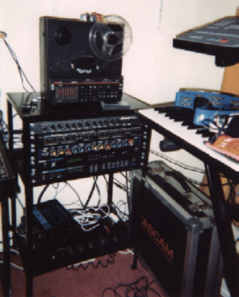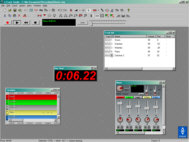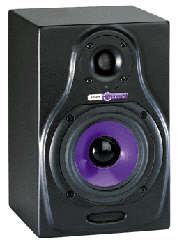The Material published on this site was recorded using
the various items of equipment as listed below :-
Fostex R8 (sentimental value only !)
Studiomaster 16-8-2 Mixing Desk
Intel Pentium III 500PC with 128 Mb RAM
SoundBlaster AWE64 8 Mb Soundcard
Casio DA-7 DAT Recorder
Jazz Midi Sequencer Software
N Track Audio Software
Yamaha DX11 Keyboard
Roland D110 Expander
Korg DDD1 Drum Machine
Fender Strat & Precision Bass
Westfield SR380-D Acoustic Guitar
HHB Circle 3 Monitors
Various Mic's & outboard effects. |
|
|
|
|
|
|
|
|
 |
| Oh Nearly forgot, a HP 8100I CD-Burner. |
|
|
|
|
|
|
|
|
Ahh.... Good Old Analog !
|
None of the above is particularly 'State of the Art' and can
all be found at reasonable prices second-hand, the two software
packages which can both be downloaded of the Internet for what
amounts to a paltry registration fee represent great value for
money and both have become a great help in the home recording set-up
allowing some stumbling first steps in the digital era !. To be
honest it has to be said that my dear old R8 and DA-7 have been
slowly pushed into the background as my knowledge grows with the
use of recording within the PC, (if there's anyone out there who
hasn't given recording on your PC a whirl yet, then give it a go
as it's bloody good fun and cheap!), in fact the recordings
released on this site have been recorded only using N-track and
Jazz.
Both these programs have proved to be much so much easier to
learn to use than the big league software (cubase, cakewalk etc.),
with N-track handling the Audio side, whilst Jazz handles the
midi. Even though N-Track has now got quite good midi facilities,
I still tend to work up a the midi side of things (drums and
keyboards) in Jazz, then import this into N-Track, this just
being the way I'm use to working .To use the old adage 'If it's
not broke, don't fix it'! It's then I start to add the rhythm
guitars, bass etc. and record the midi tracks to a stereo wave.
This forms the backing track to which finally the lead
instruments and vocals are added.
The above process is what I've adopted to ensure that I never
have too many wave files recorded at any one time i.e. I like to
build the song without having too many redundant parts(a
throwback to my previous P200 computer) which is a fairly
standard approach, which then leaves me with some raw processing
power left over to add some plug-in effects as and when required,
basically a case of trial and error until I found something that
worked for me.
It's only recently that I've managed to acquire some decent
monitoring (having previously used my 'Mission II' Hi-Fi Speakers),
but now since purchasing a set of the 'HHB Circle 3' nearfield
monitors in conjunction with a 'Samson Servo 170' Amp this
situation has somewhat improved ! For their given size the Circle
3's give out a great punchy sound, which is ideal for the small
home hobby studio where of course the physical size of a speaker
cabinet can be an important consideration.
Also a pair of speaker stands have been made to mount the
speakers on and a copy of the AutoCAD .dwg file in a .zip will be
available to download in the new 'DIY Projects' section to enable
others to manufacture there own versions based upon this drawing.
To view and print AutoCAD drawings you will need to download a
copy of the free Autodesk 'Volo View Express' Viewer obtainable
from http://www.autodesk.co.uk/volo/index.htm
Finally it should also be pointed out that the material
recorded is all original excepting the odd obvious influence or
two for which no excuses are made!
Back
to Homepage



